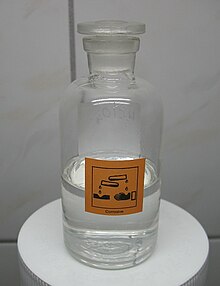Perchloric acid
| |||

| |||
| Names | |||
|---|---|---|---|
| Systematic IUPAC name
Perchloric acid | |||
| Other names
Hyperchloric acid[1]
| |||
| Identifiers | |||
3D model (
JSmol ) |
|||
| ChEBI | |||
| ChEMBL | |||
| ChemSpider | |||
ECHA InfoCard
|
100.028.648 | ||
| EC Number |
| ||
PubChem CID
|
|||
RTECS number
|
| ||
| UNII | |||
| UN number | 1873 | ||
CompTox Dashboard (EPA)
|
|||
| |||
| |||
| Properties | |||
| HClO4 | |||
| Molar mass | 100.46 g/mol | ||
| Appearance | colorless liquid | ||
| Odor | odorless | ||
| Density | 1.768 g/cm3 | ||
| Melting point | −17 °C (1 °F; 256 K) (72% aqueous solution)[2] −112 °C (anhydrous) | ||
| Boiling point | 203 °C (397 °F; 476 K) (azeotrope)[2] | ||
| Miscible | |||
| Acidity (pKa) | −15.2 (±2.0);[3] ≈ −10 | ||
Conjugate base
|
Perchlorate | ||
| Hazards | |||
| Occupational safety and health (OHS/OSH): | |||
Main hazards
|
Powerful oxidizer, highly corrosive | ||
| GHS labelling: | |||
   
| |||
| Danger | |||
| H271, H290, H302, H314, H373 | |||
| P210, P280, P303+P361+P353, P304+P340, P305+P351+P338, P310, P371, P375, P380 | |||
| NFPA 704 (fire diamond) | |||
| Flash point | Non-flammable | ||
| Safety data sheet (SDS) | ICSC 1006 | ||
| Related compounds | |||
Related compounds
|
Hydrochloric acid Hypochlorous acid Chlorous acid Chloric acid | ||
Except where otherwise noted, data are given for materials in their standard state (at 25 °C [77 °F], 100 kPa).
| |||
Perchloric acid is a
History
Perchloric acid was first synthesized (together with
This section needs expansion. You can help by adding to it. (July 2022) |
Production
Perchloric acid is produced industrially by two routes. The traditional method exploits the high aqueous solubility of sodium perchlorate (209 g/100 ml of water at room temperature). Treatment of such solutions with hydrochloric acid gives perchloric acid, precipitating solid sodium chloride:
- NaClO4 + HCl → NaCl + HClO4
The concentrated acid can be purified by distillation. The alternative route, which is more direct and avoids salts, entails anodic oxidation of aqueous chlorine at a platinum electrode.[6][7]
Laboratory preparations
Treatment of barium perchlorate with sulfuric acid precipitates barium sulfate, leaving perchloric acid. It can also be made by mixing nitric acid with ammonium perchlorate and boiling while adding hydrochloric acid. The reaction gives nitrous oxide and perchloric acid due to a concurrent reaction involving the ammonium ion and can be concentrated and purified significantly by boiling off the remaining nitric and hydrochloric acids.
Properties
Anhydrous perchloric acid is an unstable oily liquid at room temperature. It forms at least five hydrates, several of which have been characterized crystallographically. These solids consist of the perchlorate anion linked via hydrogen bonds to H2O and H3O+ centers.[8] An example is hydronium perchlorate. Perchloric acid forms an azeotrope with water, consisting of about 72.5% perchloric acid. This form of the acid is stable indefinitely and is commercially available. Such solutions are hygroscopic. Thus, if left open to the air, concentrated perchloric acid dilutes itself by absorbing water from the air.
Dehydration of perchloric acid gives the anhydride dichlorine heptoxide:[9]
- 2 HClO4 + P4O10 → Cl2O7 + H2P4O11
Uses
Perchloric acid is mainly produced as a precursor to
As an acid
Perchloric acid, a
It is also used for electropolishing or etching of aluminium, molybdenum, and other metals.
Safety
Given its strong oxidizing properties, perchloric acid is subject to extensive regulations as it can react violently with metals and flammable substances such as wood, plastics, and oils.[14] Work conducted with perchloric acid must be conducted in fume hoods with a wash-down capability to prevent accumulation of oxidisers in the ductwork.
On February 20, 1947 in Los Angeles, California, 17 people were killed and 150 injured in the O'Connor Plating Works disaster. A bath, consisting of over 1000 litres of 75% perchloric acid and 35% acetic anhydride by volume which was being used to electro-polish aluminium furniture, exploded. Organic compounds were added to the overheating bath when an iron rack was replaced with one coated with cellulose acetobutyrate (Tenit-2 plastic). A few minutes later the bath exploded.[15][16] The O'Connor Electro-Plating plant, 25 other buildings, and 40 automobiles were destroyed, and 250 nearby homes were damaged.
See also
References
- ^ Fomon, S. (1920). Medicine and the Allied Sciences. D. Appleton. p. 148.
- ^ a b "Safety (MSDS) data for perchloric acid, 70%". msds.chem.ox.ac.uk. 2 July 2008. Archived from the original on 2 July 2008. Retrieved 24 February 2022.
- ^ S2CID 29697201.
- ^ "Perchloric Acid | Environmental Health & Safety | Michigan State University". ehs.msu.edu. Retrieved 2023-11-02.
- ^ Perchloric acid and perchlorates
- ^ .
- .
- ISSN 0567-7408.
- ISBN 0-12-352651-5.
- ^ "Perchloric Acid". GFS chemicals. Archived from the original on 2015-01-31. Retrieved 2014-01-14.
- ^ "Metal Etching". Thayer School of Engineering.
- ISBN 0-8493-8081-2.
- ^ A. T. Balaban, C. D. Nenitzescu, K. Hafner and H. Kaiser (1973). "2,4,6-Trimethylpyrilium Perchlorate". Organic Syntheses
{{cite journal}}: CS1 maint: multiple names: authors list (link); Collected Volumes, vol. 5, p. 1106. - ^ "Materials Safety Data Sheet - Perchloric Acid, 60%, GR" (PDF). emd chemicals. 2003. Archived from the original (PDF) on 24 March 2012. Retrieved 24 February 2022.
- ^ R. C. Nester; G. F. Vander Voort (1992). Safety in the Metallographic Laboratory. ASTM Standardization News. p. 34.
- ^ "CALIFORNIA: The Amazing Brew". Time.com. March 3, 1947.



